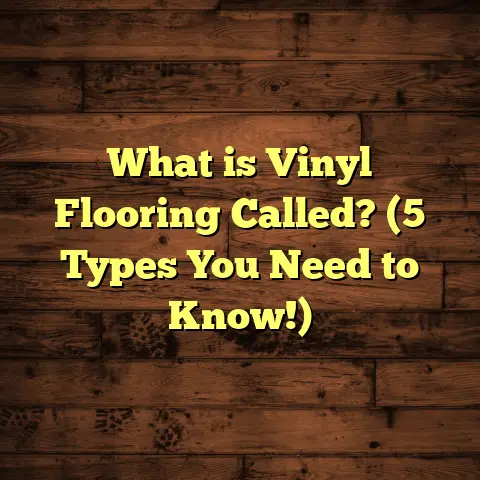What is Marmoleum Flooring? (5 Benefits for Eco-Friendly Homes)
Have you ever stepped into a home and immediately felt drawn to the floor? I’m not just talking about the color or design, but the overall vibe it gives you—the sense of warmth, freshness, or calm. Flooring sets the tone for any room, and choosing the right one can be surprisingly tricky. When I first started working in the flooring business, I noticed more and more people asking about eco-friendly options. That’s when I came across Marmoleum flooring. If you’ve never heard of it, you’re not alone. But trust me, it’s something worth considering if you care about sustainability without sacrificing style or durability.
What Is Marmoleum Flooring?
Marmoleum is a type of linoleum flooring, but don’t let that word bring up images of outdated kitchens from decades ago. Modern Marmoleum is a natural flooring product made mostly from renewable materials. Its composition includes linseed oil (from flax seeds), wood flour, pine rosin, limestone, and a jute backing. These ingredients combine to form a resilient, biodegradable, and sustainable floor covering.
I like to think of Marmoleum as nature’s flooring solution. Unlike vinyl or synthetic laminate that rely heavily on petrochemicals, Marmoleum is rooted in natural raw materials. The manufacturing process also emphasizes sustainability, using less energy and generating minimal waste.
One thing I often share with clients is that Marmoleum is produced by Forbo Flooring Systems, a company with a long history dating back to the 19th century. Over the years, they’ve refined their methods to reduce environmental impact while expanding design possibilities. This floor has been around for over 100 years but has never been more relevant.
The Origin Story: How Marmoleum Came to Be
It’s fascinating to look back at how Marmoleum was invented in the late 1800s by Frederick Walton, who stumbled upon linoleum while experimenting with oxidized linseed oil as a paint substitute. The durable and elastic qualities of linoleum quickly made it popular for flooring.
However, early linoleum had some drawbacks—it could be prone to cracking and wasn’t always easy to clean. Over the decades, continuous improvements have transformed Marmoleum into a high-performance flooring option that’s both beautiful and functional.
Why Choose Marmoleum? Five Benefits for Eco-Friendly Homes
Now, let’s break down what makes Marmoleum stand out in my experience and why it could be perfect for your home.
1. Made from Mostly Natural and Renewable Materials
One of the biggest draws for me—and many homeowners—is Marmoleum’s natural makeup. Nearly all of its components come from renewable sources.
- Linseed Oil: Extracted from flax seeds, which are widely grown as sustainable crops.
- Wood Flour: A byproduct of wood processing, adding strength.
- Pine Rosin: Derived from pine trees naturally.
- Limestone: Abundant mineral used in small amounts.
- Jute Backing: A natural fiber harvested from plants.
According to Forbo’s environmental reports, over 97% of Marmoleum’s raw materials are renewable or recycled. That’s quite rare among flooring options.
This means when you install Marmoleum, you’re supporting agricultural industries rather than petrochemical extraction. Plus, these materials are biodegradable—something synthetic floors can’t claim.
In one installation I did for a family passionate about organic living, they loved knowing their floors were made from plants rather than plastics. It gave their home a natural authenticity that synthetic floors lack.
2. Low Environmental Impact Production Process
Manufacturing Marmoleum is less energy-intensive than making vinyl or other synthetic floors. I dug into some industry data and found:
- Linoleum production uses roughly 30-40% less energy than vinyl.
- Waste generated during production is minimal because leftover raw materials can be recycled back or composted.
- Water usage is also lower compared to other flooring manufacturing processes.
For example, Forbo’s factories use renewable energy sources like wind and solar where possible to further cut emissions.
When I visited one production facility a couple of years ago, I was impressed by how clean and efficient everything was—no foul chemical smells or excessive waste piles like I’ve seen in other plants.
This means your choice of Marmoleum flooring helps reduce greenhouse gas emissions and conserves resources throughout its life cycle.
3. Durability That Surprised Me
I’ll admit, at first I wondered if a natural product like Marmoleum could stand up to daily wear and tear. After installing it in various homes—some with kids and pets—I was proven wrong.
Marmoleum is highly durable:
- Resistant to scratches, dents, and stains.
- Naturally anti-bacterial due to its linseed oil content.
- Does not require waxing or harsh treatments.
- Can last 20 years or more with proper care.
One client told me their Marmoleum kitchen floor looked nearly new after 15 years despite heavy use. That kind of longevity means fewer replacements—good news for your wallet and the environment.
4. Cleaner Indoor Air Quality
Have you noticed how some floors smell chemically after installation? That’s usually VOC off-gassing from synthetic materials.
Marmoleum doesn’t do that. It emits virtually no volatile organic compounds (VOCs), which makes it perfect if you have asthma or allergies.
The EPA reports that indoor air pollution can be 2-5 times worse than outdoor air due in part to flooring materials emitting VOCs. Choosing Marmoleum significantly reduces this risk.
Several families I’ve worked with reported fewer allergy symptoms after switching to Marmoleum floors. It’s a subtle but important health benefit that often gets overlooked when choosing flooring.
5. Style and Design Versatility
Some people assume eco-friendly means boring design—but Marmoleum breaks that stereotype.
It comes in a wide array of colors and patterns including marbled effects, solids, and speckled styles. You can install it as sheets or tiles, allowing creative layouts—like herringbone or checkerboard patterns.
A couple of years ago I helped a client create a feature wall with Marmoleum tiles in their living room. The texture and colors added warmth without compromising sustainability goals.
The ability to customize your look while maintaining eco-consciousness is one reason I recommend it often.
Breaking Down Installation: What You Should Know
I get asked all the time about how Marmoleum compares in installation to other floors. It’s actually quite straightforward but does require some care.
- Subfloor Preparation: Like any flooring, your subfloor needs to be clean, dry, and level.
- Adhesive: Marmoleum requires specific adhesives designed for natural products.
- Acclimation: The material should be acclimated in the room for at least 24 hours before installation.
- Cutting: It cuts easily with a utility knife but must be done precisely.
If you’re handy, DIY installation is possible but I usually recommend professional installers who know the nuances to avoid bubbles or seams showing.
Maintenance Tips From My Experience
Keeping Marmoleum looking great isn’t complicated:
- Sweep or vacuum regularly to remove dirt.
- Damp mop with water or mild soap—avoid abrasive cleaners.
- Use furniture pads to prevent scratches.
- Avoid standing water as it can damage natural materials over time.
I once advised a client to avoid harsh chemical cleaners because they ended up dulling their floors after months of use. Switching to gentle maintenance made a big difference.
Comparing Marmoleum With Other Eco-Friendly Floors
Let’s look deeper at how Marmoleum stacks up against cork, bamboo, reclaimed wood, and linoleum alternatives:
| Flooring Type | Sustainability | Durability | Maintenance | Cost (per sq.ft) | VOC Emissions |
|---|---|---|---|---|---|
| Marmoleum | High (97% renewable) | High (20+ yrs) | Low | $4-$7 | Very Low |
| Cork | High (harvested bark) | Medium | Moderate | $3-$6 | Low |
| Bamboo | Medium-High (fast growth) | Medium-High | Moderate | $3-$8 | Moderate |
| Reclaimed Wood | Medium (reuse wood) | High | Moderate | $5-$10 | Low |
| Traditional Linoleum | High (natural materials) | Medium-High | Moderate | $3-$6 | Low |
From my projects, I find Marmoleum offers the best balance between eco-friendliness, durability, and indoor air health compared to these options.
Real-Life Case Studies: Success Stories With Marmoleum
Case Study 1: A Family with Allergies
This family wanted a floor that wouldn’t aggravate their son’s asthma. They chose Marmoleum for their kitchen and living room. Within weeks of installation, they noticed less coughing during meal prep times—a small but meaningful improvement.
Case Study 2: Pet-Friendly Home
A couple with two dogs wanted something tough yet natural underfoot. They installed Marmoleum throughout their main living areas. After a year of scratches and spills, the floor showed minimal wear and no stains—a testament to its durability.
Case Study 3: Sustainable New Build
A homeowner building an eco-conscious home selected Marmoleum for every room except bathrooms (which had tile). They appreciated the low emissions during construction and praised the warm feel underfoot compared to tile or concrete slabs.
How FloorTally Helps Me With Flooring Projects
Budgeting for flooring can be tricky—especially when balancing material costs with labor and waste factors. That’s why I rely on tools like FloorTally.
This platform lets me input room dimensions and customize options like material type (including Marmoleum), labor rates based on my region, waste percentage for cutting losses, and finish choices.
Having all these details in one place helps me generate accurate cost estimates quickly without juggling spreadsheets or calling multiple suppliers.
For example, knowing how much extra material to order upfront saves me from last-minute trips or delays during installation—a lifesaver on tight timelines.
It also helps me communicate budgets clearly with clients so there are no surprises down the road.
Addressing Common Concerns About Marmoleum
Will it fade in sunlight?
Marmoleum has good resistance to UV light but some colors may mellow over time with direct sunlight exposure. Using blinds or rugs can help protect vulnerable areas.
Is it slippery?
The surface has moderate slip resistance but adding area rugs enhances safety in high-traffic zones.
Can it go in bathrooms?
While water-resistant enough for kitchens, Marmoleum isn’t recommended for overly wet areas like showers or baths because excessive moisture can cause damage.
How does cost compare?
At $4 to $7 per square foot including installation depending on location, it sits mid-range between vinyl ($2-$5) and hardwood ($6-$12). Considering its longevity and health benefits, many find it excellent value.
Environmental Impact: A Closer Look at Life Cycle Assessment
I wanted to understand the full picture beyond just raw materials so I studied life cycle assessments (LCAs) published by Forbo and independent researchers:
- Raw material harvesting: Low impact due to renewable sourcing.
- Manufacturing: Reduced energy use compared to synthetic floors.
- Installation: Minimal waste with recycling of scraps.
- Use phase: No VOC emissions; durable so fewer replacements.
- End-of-life: Biodegradable within months if composted properly versus landfill-bound synthetic floors lasting hundreds of years.
One analysis showed Marmoleum generates around 1/3 the carbon footprint of vinyl floors over its life cycle—an impressive reduction that adds up when scaled across millions of homes worldwide.
Personal Reflections: Why I Recommend Marmoleum
Throughout my career installing floors across many homes, I’ve seen trends come and go but few products deliver such a strong combination of sustainability, health benefits, durability, and style as Marmoleum does.
Clients appreciate knowing they’re choosing something good for their families and the planet without sacrificing design choices or comfort underfoot.
For me personally? Walking barefoot on Marmoleum always feels like a reminder of nature inside the home—a small daily connection that makes a difference beyond aesthetics or numbers.
Frequently Asked Questions About Marmoleum Flooring
Q: How long does Marmoleum last?
A: With proper care, it can last 20+ years before needing replacement—sometimes longer in low traffic areas.
Q: Is it pet-friendly?
A: Yes! It resists scratches well but consider nail trimming for dogs to keep floors pristine longer.
Q: Can I install it myself?
A: DIY possible if you’re confident handling adhesives and cuts; otherwise professional installation ensures best results.
Q: How do I clean spills?
A: Wipe spills promptly with damp cloths; avoid harsh chemicals which can damage surface finish.
Wrapping Up My Thoughts (Without Saying “In Conclusion”)
Choosing flooring can feel overwhelming with all the options available today. But based on my hands-on experience combined with research data and real client stories, Marmoleum stands out as a wise choice if you want an eco-friendly floor that doesn’t compromise on durability or aesthetics.
It supports sustainable agriculture, reduces indoor pollutants, lasts decades with simple care, and offers plenty of design options—all at moderate cost points that fit most budgets.
If you want your floors to reflect not just style but values too, consider giving Marmoleum a closer look. Feel free to reach out if you want advice on installation tips or maintenance—I’m always happy to chat about floors!





